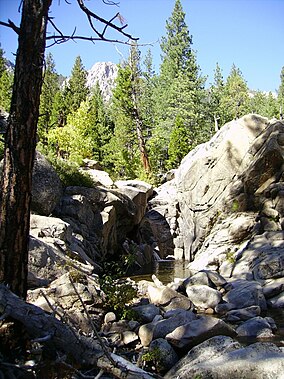Grover Hot Springs State Park
| Grover Hot Springs State Park | |
|---|---|
 Streambed and waterfall at Grover Hot Springs | |
| Location | Alpine County, California, USA |
| Nearest city | Markleeville, California |
| Area | 553 acres (224 ha) |
| Established | 1959 |
| Governing body | California Department of Parks and Recreation |
Grover Hot Springs State Park is a state park of California, USA, containing natural hot springs on the eastern side of the Sierra Nevada. Park amenities include a swimming pool complex fed by the hot springs, as well as a campground, picnic area, and hiking trails.[1] The 553-acre (224 ha) park was established in 1959.[2]
Name
Named for Alvin M Grover on whose homestead the springs are situated and was county assessor.[3]
Geography
Grover Hot Springs State Park is located at 5,900 feet (1,800 m) in the northern Sierra Nevada, at the edge of the Great Basin. Vegetation consists mainly of pine forest, sagebrush, and open meadows. The park is open all year allowing visitors to experience a variety of weather conditions, from major blizzards to dry days, from warm clear nights to intense, blasting thunderstorms. Winds of great speed coming off the mountains are capable of whipping through the park causing damage during any month of the year.[1]
Hot springs and pools
The mineral deposits on the bottom of the pool cause refracted light to lose certain wavelengths; a distinct yellow-green hue is noticeable. These mineral deposits are laid down on the bottom by an oxidation reaction between the mineral salts in the water and the bromine used as a sanitizing agent. The pool complex is generally open every day (except Wednesday) from June through August for public wading. The pools close during nearby thunderstorms due to the possibility of lightning striking the water. During the winter, the pool complex will usually remain open.[1]
Technical data
| Temperature | 147 °F | 41 °C |
| Flow | 105 gpm | 398 L/min |
| Capacity | 0.6×106 BTU/h | 0.2 MWt |
| Annual energy | 4.7×109 BTU | 1.4 GWh |
| Sodium | 440 | Iron | < 0.02 |
| Potassium | 13 | Manganese | 0.08 |
| Lithium | 0.82 | Ammonia | < 0.10 |
| Rubidium | 0.06 | Bicarbonate | 775 |
| Cesium | 0.1 | Carbonate | < 1.0 |
| Calcium | 31 | Sulfate | 160 |
| Magnesium | 1.9 | Chloride | 190 |
| Aluminum | 0.002 | Fluoride | 4.2 |
| Silica | 100 | Boron | 3.1 |
| Sulfide | < 0.05 |
| Cobalt | < 50 | Copper | < 10 |
| Cadmium | < 10 | Mercury | < 0.1 |
| Nickel | < 20 | Lead | < 100 |
| Zinc | 110 |
| Oxygen+argon | 1.4 |
| Nitrogen | 62.0 |
| Methane | 0.34 |
| Carbon dioxide | 36.4 |
See also
References
- ^ a b c "Grover Hot Springs SP". California State Parks. Retrieved 2012-01-30.
- ^ "California State Park System Statistical Report: Fiscal Year 2009/10" (PDF). California State Parks: 32. Retrieved 2012-01-30.
{{cite journal}}: Cite journal requires|journal=(help) - ^ Gudde, Erwin G. (1998). California place names : the origin and etymology of current geographical names (4th ed., rev. and enl. ed.). Berkeley: University of California Press. p. 154. ISBN 0520213165.
- ^ "Grover Hot Springs State Park". Geo-Heat Center. 2012-01-01. Retrieved 2012-01-30.
- ^ a b c Grover Hot Springs information plaque on location

